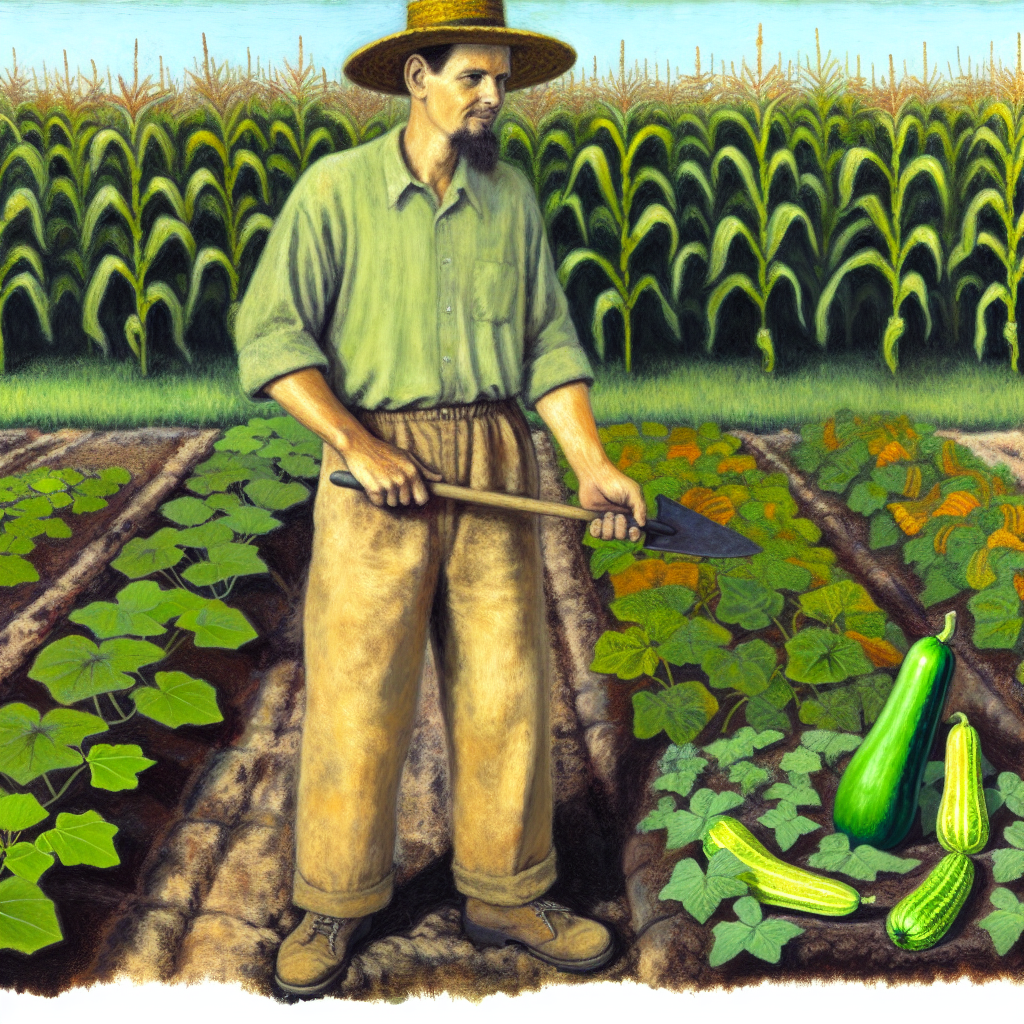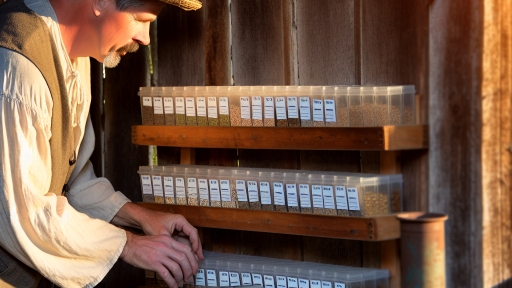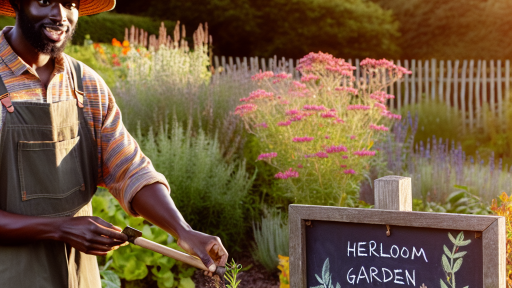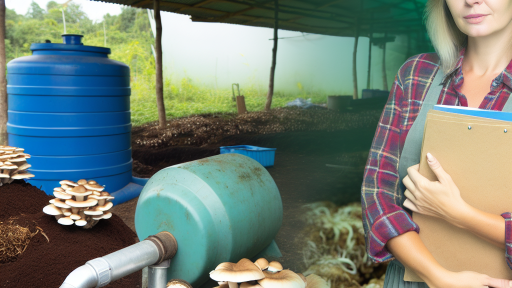Introduction to Companion Planting
Companion planting is an effective technique for farmers and gardeners alike.
This method involves planting different crops together for mutual benefits.
It enhances growth, repels pests, and improves overall crop health.
Many organic farmers utilize companion planting to optimize their yields.
This practice aligns well with sustainable agriculture principles.
Benefits of Companion Planting for Organic Farming
One key benefit is pest management.
Certain plants repel insects that harm crops.
For example, marigolds deter nematodes and aphids.
Moreover, improved pollination occurs with diverse plant species.
Enhancing Soil Health
Companion plants can enrich the soil through nitrogen fixation.
Legumes, like clover and beans, are great for this purpose.
They add essential nutrients back into the soil.
This practice reduces the need for synthetic fertilizers.
Increasing Biodiversity
By implementing companion planting, farmers foster biodiversity.
This encourages a healthy ecosystem within the farm.
Transform Your Agribusiness
Unlock your farm's potential with expert advice tailored to your needs. Get actionable steps that drive real results.
Get StartedDiverse plant species attract beneficial insects and pollinators.
Increased biodiversity can reduce disease outbreaks.
Optimizing Crop Yields
Companion planting often leads to higher crop yields.
Crops can thrive with the support of their neighbors.
For instance, planting corn with beans can maximize space and resources.
Creating Plant Pairings
Farmers can create plant pairings based on compatibility.
Some effective combinations include:
- Tomatoes with basil to enhance flavor and growth.
- Carrots paired with onions to deter pests.
- Cucumbers and radishes to improve soil conditions.
Managing Resources Efficiently
With thoughtful planning, farmers can manage light and water effectively.
Tall plants provide shade and windbreaks for shorter crops.
This arrangement can lead to better resource utilization.
Farmers like Ava Green of Green Acres Farm have seen great results.
Top Companion Plants for Vegetables: Enhancing Growth and Flavor
Boosting Growth with Marigolds
Marigolds are excellent companions for many vegetables.
They repel harmful nematodes and insects, protecting nearby plants.
Additionally, marigolds enhance the growth of tomatoes and peppers.
Planting them close creates a natural pest barrier.
Improving Flavor with Basil
Basil pairs wonderfully with tomatoes, enhancing their flavor profile.
It also attracts beneficial insects, which help pollinate nearby crops.
Moreover, basil’s aromatic oils deter pests like aphids and flies.
Growing basil near tomatoes can lead to a richer harvest.
Combining Beans with Corn
Beans and corn make a classic companion planting duo.
Beans fix nitrogen in the soil, benefitting the corn plants.
In return, corn provides support for climbing bean varieties.
This relationship promotes sustainable growing practices.
Enhancing Growth with Radishes
Radishes are quick to mature, making them ideal companions.
Showcase Your Farming Business
Publish your professional farming services profile on our blog for a one-time fee of $200 and reach a dedicated audience of farmers and agribusiness owners.
Publish Your ProfileThey naturally deter pests like cucumber beetles and aphids.
Additionally, their root systems can help break up compacted soil.
Planting radishes among slower-growing crops can optimize space.
Encouraging Pollinators with Flowers
Flowers like lavender and borage attract crucial pollinators.
Incorporating these plants into your vegetable garden is beneficial.
Pollinators improve the yield of crops such as squash and cucumbers.
Furthermore, these blooms add beauty and diversity to your farm.
Using Garlic for Pest Control
Garlic is an excellent natural pest deterrent for vegetable gardens.
Its strong scent repels aphids, beetles, and other garden pests.
Planting garlic amongst crops like peppers and tomatoes boosts resilience.
Additionally, garlic’s antifungal properties promote healthy plants.
Herbs as Companion Plants: Pest Control and Growth Promotion
Benefits of Using Herbs
Herbs play a vital role in companion planting on organic farms.
They naturally repel pests, reducing the need for chemical pesticides.
Additionally, many herbs enhance the growth of neighboring plants.
Effective Herbs for Pest Control
Several herbs are particularly effective at controlling pests.
For example, basil wards off aphids and whiteflies.
Likewise, mint is known to deter ants and many beetles.
Other useful herbs include marigold and rosemary.
Herbs That Promote Healthy Growth
Some herbs boost the growth of other plants.
For example, cilantro helps tomatoes thrive while adding flavor.
Additionally, dill is known to enhance the growth of cucumbers.
These companions create a mutually beneficial environment.
Implementing Companion Planting Strategies
Integrate herbs into your crop rotation for pest management.
Start by choosing herbs that suit your growing conditions.
Next, plant herbs in proximity to susceptible crops.
Regularly monitor plant health to assess the impact.
Tips for Successful Companion Planting
- Use companion plants that have complementary growth habits.
- Space plants to allow air circulation and sunlight penetration.
- Rotate herb plantings to maintain soil health and reduce pests.
- Observe plant interactions and adjust plant placements accordingly.
You Might Also Like: Maximizing Yields with Edible Landscaping
Flowers that Attract Pollinators: Boosting Crop Yields
The Role of Pollinators in Agriculture
Pollinators play a critical role in agriculture.
They enhance pollination and, as a result, boost crop yields.
Without pollinators, many crops would produce significantly lower yields.
By attracting these beneficial insects, farmers can improve their harvests.
Choosing the Right Flowers
Selecting the appropriate flowers maximizes pollination effectiveness.
Different flowers attract various types of pollinators.
Consider planting a diverse array of flowers to attract more species.
Sunflowers, lavender, and zinnias are excellent choices.
Planting Techniques for Optimal Results
Planting in clusters encourages better pollinator visits.
Space flowers strategically among crops for favorable interactions.
Moreover, ensure flowers bloom at different times.
This continuous flowering provides essential forage for pollinators.
Integrating Flowers into Crop Layouts
Incorporate flowers into the margins of your fields.
Showcase Your Farming Business
Publish your professional farming services profile on our blog for a one-time fee of $200 and reach a dedicated audience of farmers and agribusiness owners.
Publish Your ProfileThis method creates a more inviting habitat for pollinators.
You can also intersperse flowers within crop rows.
Additionally, using ground covers can enhance flower presence.
Maintaining Flower Health
Regular maintenance promotes vibrant flower growth.
Watering and weeding ensure flowers thrive and attract pollinators.
Using organic methods avoids harming beneficial insects.
Finally, rotate flowers yearly to prevent pest buildup.
Measuring the Impact of Pollinators
Observing pollinator activity can help gauge their impact.
Note changes in crop yields following floral integration.
Collecting data will inform future planting decisions.
Engagement with agricultural extensions can enhance knowledge.
Learn More: Crop Rotation Plans for Organic Farmers
The Science Behind Companion Planting
Understanding Plant Relationships
Companion planting involves growing different plant species together.
This technique enhances growth, protects against pests, and improves flavor.
Plants interact through various mechanisms, forming beneficial relationships.
These relationships can be categorized into three main types: mutualism, commensalism, and competition.
Mutualism in Companion Plants
In mutualistic relationships, both plants benefit mutually from their interaction.
For example, legumes fix nitrogen, enhancing soil fertility for neighboring crops.
Another example is the relationship between tomatoes and basil.
Basil repels insects that would harm tomatoes while enhancing their flavor.
Commensalism Among Plants
Commensalism occurs when one plant benefits without harming the other.
An excellent example is planting corn with squash and beans.
The corn provides support for the beans, while beans fix nitrogen in the soil.
Squash benefits from shade and ground cover, enhancing overall growth.
Competition Between Plants
While competition usually presents challenges, it can also offer insights.
Some plants compete for resources, impacting growth and yield.
Understanding these dynamics helps farmers plan effective planting strategies.
Crop rotation and careful planning reduce detrimental competition effects.
Ecological Benefits of Companion Planting
Companion planting fosters biodiversity in farming systems.
This practice improves pest management and promotes soil health.
Moreover, it helps in reducing the need for chemical fertilizers and pesticides.
Ultimately, this leads to more resilient and sustainable farming practices.
Maximizing Plant Interactions for Farming Success
Understanding the science behind plant relationships is essential.
By harnessing the benefits of companion planting, farmers can enhance productivity.
This approach aligns well with the principles of organic farming.
Therefore, applying these strategies can significantly impact crop success.
See Related Content: Selecting Seeds For Maximum Crop Yield

Common Companion Planting Mistakes to Avoid on Organic Farms
Overcrowding Crops
Overcrowding can stunt growth and reduce yields.
Plants need adequate space for air circulation and sunlight.
It is important to plan spacing based on each crop’s requirements.
Showcase Your Farming Business
Publish your professional farming services profile on our blog for a one-time fee of $200 and reach a dedicated audience of farmers and agribusiness owners.
Publish Your ProfileFurthermore, crowded plants are more susceptible to diseases.
Ignoring Plant Compatibility
Not all plants benefit from each other when grown together.
For instance, some may attract pests while others deter them.
This could lead to increased pest issues and reduced harvests.
Researching companion planting benefits maximizes productivity.
Neglecting Soil Health
Healthy soil is essential for successful companion planting.
Mixing plants can deplete nutrients if not managed carefully.
Rotate crops and incorporate organic matter to maintain soil health.
Testing soil regularly helps identify nutrient deficiencies.
Underestimating Pest Control Benefits
Companion planting can effectively control pest populations.
However, ignoring this aspect can lead to pest overpopulation.
Incorporate pest-repelling plants to protect vulnerable crops.
This strategy can reduce the need for chemical pesticides.
Neglecting Seasonal Changes
Seasons affect plant growth and compatibility.
Some plants thrive in warmer weather, while others prefer cooler temperatures.
Plan your planting schedule based on seasonal changes.
This ensures the best pairing of plants throughout the year.
Failing to Monitor Growth
Regularly monitoring plant growth is crucial for success.
One should observe changes that may affect plant health.
Additionally, adjustments may be necessary during the growing season.
This proactive approach can lead to better yields.
Overlooking Companion Planting Documentation
Keeping records of which plants paired well is beneficial.
This information guides future planting decisions.
Documenting successes and failures facilitates learning and improvement.
Moreover, it helps refine your organic farming practices.
Gain More Insights: Organic Seed Saving Techniques For Farmers
Seasonal Companion Planting Strategies
Understanding Timing
Timing is crucial when planning companion planting initiatives.
Planting crops at specific times enhances their mutual benefits.
Seasonal changes impact soil temperature and moisture levels.
Adjust planting schedules according to your local climate.
Spring Planting Strategies
Spring marks the ideal time for many companion crops.
For instance, plant tomatoes alongside basil to boost flavor.
Consider pairing peppers with onions to deter pests.
Additionally, planting marigolds can attract beneficial insects.
Summer Companion Planting
During summer, focus on maximizing your garden’s yield.
Interplanting beans with corn can offer structural support.
Also, squash plants benefit from the shade provided by taller crops.
Finally, grow cilantro alongside tomatoes for added flavor.
Fall Planting Techniques
Fall provides unique opportunities for companion planting.
Consider sowing cover crops to improve soil health over winter.
Showcase Your Farming Business
Publish your professional farming services profile on our blog for a one-time fee of $200 and reach a dedicated audience of farmers and agribusiness owners.
Publish Your ProfilePlanting garlic beneath fruit trees can repel unwanted pests.
Moreover, using clover can enhance nitrogen levels in the soil.
Placement Considerations
Placement affects companion planting success significantly.
Position taller plants to the north to prevent shading others.
Ensure that plants with similar water needs are grouped together.
Also, consider spacing to allow for ample air circulation.
Case Studies: Successful Companion Planting in Organic Farms
Introduction to Companion Planting
Companion planting enhances the growth of plants when placed together.
This technique benefits organic farmers by improving biodiversity.
Moreover, it helps in pest management and enhances soil health.
Case Study: Green Valley Organic Farm
Green Valley Organic Farm employs companion planting effectively.
They grow tomatoes alongside basil and marigolds.
This combination repels pests and enhances tomato flavor.
Additionally, it attracts pollinators, boosting overall yields.
Results and Observations
The farm reported a 30% increase in tomato production.
They also noted a significant reduction in pest damage.
Workers found that soil quality improved year over year.
Case Study: Harmony Acres
Harmony Acres focuses on growing carrots with onions.
This pairing is beneficial due to their natural pest repellent properties.
Carrots thrive while onions discourage pests like carrot flies.
Results and Observations
Harmony Acres experienced a robust carrot harvest this season.
Furthermore, onion growth occurred without any pest issues.
The farm saw lower pesticide usage, promoting better health.
Case Study: Sunny Meadows Farm
Sunny Meadows Farm showcases the success of planting corn with beans and squash.
This trio, known as the Three Sisters, supports each other effectively.
Corn provides support, beans fix nitrogen, and squash covers ground.
Results and Observations
Sunny Meadows reported a harmonious growth cycle among these plants.
Water retention improved due to the squash’s ground cover.
Harvests were plentiful and nutrient-dense this year.
Implications for Organic Farming
These case studies illustrate the effectiveness of companion planting.
Moreover, they highlight the adaptability and benefits for organic farming.
Farmers can increase yields while reducing environmental impacts.
Additional Resources
Companion Planting Flowers for Your Vegetable Garden – Forks in …




